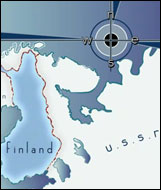

Preparations for the War
In the first week of June 1941, long range patrols were sent by the
Finns into the Karelian Isthmus areas to scout out Soviet defenses
and positions. On June 6, German troops began to unload in Finland,
the main German forces started to arrive at the Finn port of Pohjanmaa.
By the June 15, the Germans were granted the right to operate in
the Lapland area of Finland. Finnish troops in the area were placed
under German control. In this same time frame, some Finnish patrols
reached as deep as Viipuri (known at the time and now as Vyborg,
Russia).
The Finnish Army is mobilized on the June 17 and 475,000 Finn soldiers were ready for battle by the end of the month. On June 20, civilians were moved from border areas, mainly due to the efforts of the Finnish border guards. On the June 21-22, Finnish and German naval forces begin to mine the areas around Finland, with one Finnish submarine mining the areas around Estonia.
The War Begins
When Germany attacked the Soviet Union on June 2, 1941, Finland declared
itself neutral, but there were German bombers using Finnish bases
to refuel their planes and using Finnish air space to attack points
inside the Soviet Union. There were also German troops in the Lapland
area that moved to take the town of Petsamo. Inside the Finnish
borders the Soviet base at Hanko fired on the Finnish Navy and
the Red Army Air Force hit at least 15 different target areas.
By the June 25, after a massive Soviet air strike, Finland had
stated that the Soviet Union had declared war, and that Finland
must once again defend itself from the Soviet threat. Mannerheim
moved his headquarters to Mikkeli, which is the same location used
during the Winter War. By the end of June there were some Finnish-Soviet
border clashes, and the German soldiers had moved from Lapland
across the Soviet border. The Finnish Independent Detachment Petsamo
was attached to German units. Their goal was to push toward Murmansk
and the key areas around this Soviet city.
First Attacks
Mannerheim decided the best place to strike
was against the Soviet forces in the area of Ladoga-Karelia and not
towards Leningrad
and the Karelian Isthmus. He ordered the attacks to begin on July
9. The Finnish forces went forward, and within a week’s time
met with success. One of the main reasons for this success was
that, unlike the Winter War, the Finns enjoyed numerical superiority
over the Red Army in this region. The Finnish soldiers were also
well commanded and well trained. The lessons learned during the
Winter War showed on the battlefield. The Finnish forces were successful
in splitting the Soviets in two and there were Finnish commanders
who wished to push the attack forward to the Svir River. However,
Mannerheim stopped the advance telling his commanders to hold in
place. By August 23 the Finns had captured Suojärvi which
was the last holdout in the region.
The Isthmus
On July 30, the Finns began their attacks on the Karelian Isthmus
with the attacks centered between Simpele and Rautjärvi. The
main goal of this offensive was to take back Viipuri and move into
key positions on the Isthmus. The first main attack was in the
area of Hiitola and the aim was to cut off supply and communication
between the Soviet forces in the area of Ladoga. The fighting in
this region was hard and there was loss of life on all sides during
these battles. Still the Finns were able to advance quickly and
retook Viipuri by August 29. The Finnish advances threatened to
encircle and trap the Soviets defending the city, so the Soviets
decided that a retreat was the only way to survive. This victory
was important to the Finns. The famous city had been lost during
the Winter War. It was a city that meant a lot to the Finns, symbolically
at least. By September, the Finns had moved into the area of the
old 1939 border and stopped in place. In some cases they did advance
past the old border but this was to take advantage of natural terrain
improving Finnish defensive positions.
North of Lake Ladoga
For the most part, the fighting above Lake Ladoga was going well
for the Finns, but the same could not be said for the German forces.
The German attacks towards Murmansk were stalling as the Soviet
resistance was greater than expected. Still, the Finns had met
their goals in the region and the areas of Karelia that had been
lost to the Soviets in the Winter War had been retaken (but for
Hanko). The question the Finns began to face at this point was
how far they would go into Soviet territory. The question had not
been addressed before the fighting started. This was a very big
question, and one the Finns could not take lightly. They had entered
the war stating their goal was to retake the land lost in the Winter
War and it had been done. If they did go further, just how much
further would they be willing to go? After a debate, it was decided
the Finns must advance in Karelia to allow a better defensive position.
This would also assist in stopping Soviet bombing of Finland from
bases in these areas.
Eastern Karelia
On September 4, the operations that would lead to the Finnish occupation
of areas of Eastern Karelia began. The first attacks were in the
general direction of the Svir River. On the right flank of the
Karelian Army there quickly followed a strike of the armored division.
The target was the village of Aunus, which fell on the September
5. The Soviet positions on the Svir River were taken by the September
7-9. The Finns crossed to the other side of the river to make use
of the better roads located on the opposite riverbank. As such,
the Finns were approximately 12 miles on the other side of the
river on a 60-mile front – starting at the city of Osta and
running to the west from that location. The left flank of the Karelian
Army also began its advance on the September 14-15 with its goal
being the capitol of Eastern Karelia, Petrozavodsk. The fighting
was hard in this time frame but by October 10, the Soviets left
the city to the Finnish Army. The next Finnish operation was undertaken
just after the fall of Petrozavodsk, and the goal was to improve
and secure defensive positions between Lake Onega and Lake Segozero.
The city of Medvezh’egorsk was also a major target goal of
the Finns. Mannerheim wanted to push this attack quickly but the
fighting was quite hard. The land area was tough to control and
the Soviet defenders put up a bitter defense. However, by December
5, this area was secured by the Finns. The result of this attack
gave the Finns major control points on the Maaselkä Isthmus.
The Finnish attacks and success in this region were problematic to the Soviets. This advance threatened Leningrad and was seen as a very real threat to cut the Murmansk railroad. If this was done, supplies that were greatly needed by the Soviet Union would be cut off. This was so dire that if the railroad was cut off, the war might end with a German victory. Much of the allied aid going to the interior of the Soviet Union, as well as aid from a still non-combatant United States, was coming via this railway. A section of this railway had already been cut by the Finns in their attacks in Eastern Karelia.
Stalin began to pressure Churchill to assist in stopping the Finnish advance. He hoped the threat of Great Britain declaring war on Finland might halt the Finns. Churchill sent a personal letter to Mannerheim on December 1, asking for the Finnish advance to be halted. Churchill informed Mannerheim that unless the Finnish actions were stopped that England would be forced to declare war on Finland. While it is clear that Mannerheim both respected and liked Churchill, he felt the attacks had to continue to strengthen the Finnish positions. England declared war on Finland on December 6. Interestingly, the Finns were in the process of halting their advances when England declared war but, Churchill was not informed.
Mannerheim told the Germans that a Finnish attack on the Murmansk area was pending but, it seemed these plans were to be halted. The reasons were mainly political. The Finns were also faced with the fact the U.S. might declare war on Finland, which had been threatened if the Murmansk railway was cut. Mannerheim was also worried that if the Germans were to lose the war this advance might be costly later in terms of Finnish lives. On December 6, the Soviets started to counterattack the Germans which halted their advance towards Moscow and this did not encourage the Finns’ feelings about German success in the war. The Finns had done few joint military operations with the Germans up to this point and more joined actions seemed unlikely.
Finland was again in a difficult position as the Germans pressed the Finns to increase their attacks. There was no possibility of the Finns directly attacking Leningrad, which was a bone of contention with the Germans. The Finns knew that an attack on Leningrad would not be forgiven by the Soviets. Had the Finns attacked Leningrad and the Germans were to still lose the war, the Soviet retributions on the Finns would have been quite harsh. This was the same attitude the Finns took in the areas of the White Sea as their advances were halted. Additional Finnish offensive operations would be too costly in political terms in case the war turned against them. There was also only mild support in the Finnish population for more aggressive actions, since the Finns felt their war goals had been a success. Any further gains would seem more a war of aggression and conquest, not a continuation of the Winter War. There were also the losses. The Finns lost 25,475 killed or wounded, by the end of December. Part of these losses came in a large Soviet counteract on the Svir River near the city of Gora where the Soviet 114th Division attempted to push the Finnish lines. There was still some talk about Finn/German joint attacks but the chances of these began to fade as Mannerheim lost confidence in the German command.
This was to end the Finnish offensive stage of the Continuation War. The Finns slowly started to let older men leave army service and return to home, while all those soldiers of fighting age began to dig in for what was to come.





